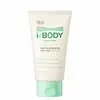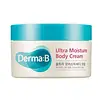What's inside
What's inside
 Key Ingredients
Key Ingredients

 Benefits
Benefits

 Concerns
Concerns

 Ingredients Side-by-side
Ingredients Side-by-side

Water
Skin ConditioningGlycerin
HumectantButylene Glycol
HumectantTriethylhexanoin
MaskingCaprylic/Capric Triglyceride
MaskingCetearyl Alcohol
EmollientPolyglyceryl-3 Methylglucose Distearate
EmulsifyingPentaerythrityl Stearate/Caprate/Caprylate/Adipate
EmollientPanthenol
Skin ConditioningCetearyl Olivate
Butyrospermum Parkii Butter
Skin ConditioningGlyceryl Stearate
EmollientDipentaerythrityl Pentaisononanoate
EmollientStearyl Alcohol
EmollientTrehalose
HumectantGlycine Soja Oil Unsaponifiables
EmollientTriticum Vulgare Germ Oil Unsaponifiables
EmollientOlea Europaea Oil Unsaponifiables
Skin ConditioningArgania Spinosa Kernel Oil
EmollientPollen Extract
EmollientSorbitan Olivate
EmulsifyingCaprylyl Glycol
EmollientCarbomer
Emulsion StabilisingAmmonium Acryloyldimethyltaurate/Beheneth-25 Methacrylate Crosspolymer
Emulsion StabilisingSodium Polyacryloyldimethyl Taurate
Emulsion StabilisingDipropylene Glycol
HumectantCetyl Ethylhexanoate
EmollientHydrogenated Polydecene
EmollientTrisiloxane
Skin ConditioningLactobacillus Ferment Lysate
Skin ConditioningBifida Ferment Lysate
Skin ConditioningStreptococcus Thermophilus Ferment
HumectantEthylhexyl Palmitate
EmollientHydrogenated Lecithin
EmulsifyingDisodium EDTA
Trideceth-10
Cleansing1,2-Hexanediol
Skin ConditioningCholesterol
EmollientHydrolyzed Hyaluronic Acid
HumectantCeramide NP
Skin ConditioningPalmitic Acid
EmollientStearic Acid
CleansingBeta-Glucan
Skin ConditioningEthylhexylglycerin
Skin ConditioningPentylene Glycol
Skin ConditioningHydroxyacetophenone
AntioxidantTocopherol
AntioxidantTromethamine
BufferingWater, Glycerin, Butylene Glycol, Triethylhexanoin, Caprylic/Capric Triglyceride, Cetearyl Alcohol, Polyglyceryl-3 Methylglucose Distearate, Pentaerythrityl Stearate/Caprate/Caprylate/Adipate, Panthenol, Cetearyl Olivate, Butyrospermum Parkii Butter, Glyceryl Stearate, Dipentaerythrityl Pentaisononanoate, Stearyl Alcohol, Trehalose, Glycine Soja Oil Unsaponifiables, Triticum Vulgare Germ Oil Unsaponifiables, Olea Europaea Oil Unsaponifiables, Argania Spinosa Kernel Oil, Pollen Extract, Sorbitan Olivate, Caprylyl Glycol, Carbomer, Ammonium Acryloyldimethyltaurate/Beheneth-25 Methacrylate Crosspolymer, Sodium Polyacryloyldimethyl Taurate, Dipropylene Glycol, Cetyl Ethylhexanoate, Hydrogenated Polydecene, Trisiloxane, Lactobacillus Ferment Lysate, Bifida Ferment Lysate, Streptococcus Thermophilus Ferment, Ethylhexyl Palmitate, Hydrogenated Lecithin, Disodium EDTA, Trideceth-10, 1,2-Hexanediol, Cholesterol, Hydrolyzed Hyaluronic Acid, Ceramide NP, Palmitic Acid, Stearic Acid, Beta-Glucan, Ethylhexylglycerin, Pentylene Glycol, Hydroxyacetophenone, Tocopherol, Tromethamine
Water
Skin ConditioningGlycerin
HumectantButylene Glycol
HumectantHydrogenated Poly(C6-14 Olefin)
EmollientCetearyl Alcohol
EmollientSorbitan Stearate
EmulsifyingCaprylic/Capric Triglyceride
MaskingVitis Vinifera Seed Oil
EmollientStearic Acid
CleansingGlyceryl Stearate
EmollientCetyl Ethylhexanoate
EmollientButyrospermum Parkii Butter
Skin ConditioningTheobroma Cacao Seed Butter
EmollientBeeswax
Emulsion StabilisingEuphorbia Cerifera Wax
Corylus Avellana Seed Oil
EmollientAllantoin
Skin ConditioningXanthan Gum
EmulsifyingArginine
MaskingChamaecyparis Obtusa Water
MaskingPanthenol
Skin ConditioningSodium Hyaluronate
HumectantDimethicone
EmollientSodium Polyacrylate
AbsorbentCyclopentasiloxane
EmollientTrideceth-6
EmulsifyingPEG/PPG-18/18 Dimethicone
EmulsifyingCarbomer
Emulsion StabilisingDipentaerythrityl Hexa C5-9 Acid Esters
Skin ConditioningTocopheryl Acetate
AntioxidantPalmitoyl Pentapeptide-4
Skin ConditioningDisodium EDTA
Caprylyl Glycol
Emollient1,2-Hexanediol
Skin ConditioningSodium Anisate
AntimicrobialParfum
MaskingWater, Glycerin, Butylene Glycol, Hydrogenated Poly(C6-14 Olefin), Cetearyl Alcohol, Sorbitan Stearate, Caprylic/Capric Triglyceride, Vitis Vinifera Seed Oil, Stearic Acid, Glyceryl Stearate, Cetyl Ethylhexanoate, Butyrospermum Parkii Butter, Theobroma Cacao Seed Butter, Beeswax, Euphorbia Cerifera Wax, Corylus Avellana Seed Oil, Allantoin, Xanthan Gum, Arginine, Chamaecyparis Obtusa Water, Panthenol, Sodium Hyaluronate, Dimethicone, Sodium Polyacrylate, Cyclopentasiloxane, Trideceth-6, PEG/PPG-18/18 Dimethicone, Carbomer, Dipentaerythrityl Hexa C5-9 Acid Esters, Tocopheryl Acetate, Palmitoyl Pentapeptide-4, Disodium EDTA, Caprylyl Glycol, 1,2-Hexanediol, Sodium Anisate, Parfum
 Reviews
Reviews

Ingredients Explained
These ingredients are found in both products.
Ingredients higher up in an ingredient list are typically present in a larger amount.
1,2-Hexanediol is a synthetic liquid and another multi-functional powerhouse.
It is a:
- Humectant, drawing moisture into the skin
- Emollient, helping to soften skin
- Solvent, dispersing and stabilizing formulas
- Preservative booster, enhancing the antimicrobial activity of other preservatives
Butylene Glycol (or BG) is used within cosmetic products for a few different reasons:
Overall, Butylene Glycol is a safe and well-rounded ingredient that works well with other ingredients.
Though this ingredient works well with most skin types, some people with sensitive skin may experience a reaction such as allergic rashes, closed comedones, or itchiness.
Learn more about Butylene GlycolThis ingredient is also known as shea butter. It is an effective skin hydrator and emollient.
Emollients help soothe and soften your skin. It does this by creating a protective film on your skin. This barrier helps trap moisture and keeps your skin hydrated. Emollients may be effective at treating dry or itchy skin.
Shea butter is rich in antioxidants. Antioxidants help fight free-radicals, or molecules that may harm the body. It is also full of fatty acids including stearic acid and linoleic acid. These acids help replenish the skin and keep skin moisturized.
While Shea Butter has an SPF rating of about 3-4, it is not a sunscreen replacement.
Shea butter may not be fungal acne safe. We recommend speaking with a professional if you have any concerns.
Learn more about Butyrospermum Parkii ButterThis ingredient is an emollient, solvent, and texture enhancer. It is considered a skin-softener by helping the skin prevent moisture loss.
It helps thicken a product's formula and makes it easier to spread by dissolving clumping compounds.
Caprylic Triglyceride is made by combining glycerin with coconut oil, forming a clear liquid.
While there is an assumption Caprylic Triglyceride can clog pores due to it being derived from coconut oil, there is no research supporting this.
Learn more about Caprylic/Capric TriglycerideCaprylyl Glycol is a humectant and emollient, meaning it attracts and preserves moisture.
It is a common ingredient in many products, especially those designed to hydrate skin. The primary benefits are retaining moisture, skin softening, and promoting a healthy skin barrier.
Though Caprylyl Glycol is an alcohol derived from fatty acids, it is not the kind that can dry out skin.
This ingredient is also used as a preservative to extend the life of products. It has slight antimicrobial properties.
Learn more about Caprylyl GlycolCarbomer is a polymer of acrylic acid. Its main role is to create a gel consistency.
A high amount of carbomer can cause pilling or balling up of products. Don't worry, most products contain 1% or less of carbomer.
Cetearyl alcohol is a mixture of two fatty alcohols: cetyl alcohol and stearyl alcohol. It is mainly used as an emulsifier. Emulsifiers help prevent the separation of oils and products. Due to its composition, it can also be used to thicken a product or help create foam.
Cetearyl alcohol is an emollient. Emollients help soothe and hydrate the skin by trapping moisture.
Studies show Cetearyl alcohol is non-toxic and non-irritating. The FDA allows products labeled "alcohol-free" to have fatty alcohols.
This ingredient is usually derived from plant oils such as palm, vegetable, or coconut oils. There is debate on whether this ingredient will cause acne.
Due to the fatty acid base, this ingredient may not be Malassezia folliculitis safe.
Learn more about Cetearyl AlcoholCetyl Ethylhexanoate is an emollient ester. It comes from cetearyl alcohol and 2-ethylhexanoic acid.
Cetyl Ethylhexanoate is an emollient that adds a velvety feel to skin without being greasy or oily. Emollients help trap moisture into your skin, keeping your skin soft and hydrated.
Disodium EDTA plays a role in making products more stable by aiding other preservatives.
It is a chelating agent, meaning it neutralizes metal ions that may be found in a product.
Disodium EDTA is a salt of edetic acid and is found to be safe in cosmetic ingredients.
Learn more about Disodium EDTAGlycerin is already naturally found in your skin. It helps moisturize and protect your skin.
A study from 2016 found glycerin to be more effective as a humectant than AHAs and hyaluronic acid.
As a humectant, it helps the skin stay hydrated by pulling moisture to your skin. The low molecular weight of glycerin allows it to pull moisture into the deeper layers of your skin.
Hydrated skin improves your skin barrier; Your skin barrier helps protect against irritants and bacteria.
Glycerin has also been found to have antimicrobial and antiviral properties. Due to these properties, glycerin is often used in wound and burn treatments.
In cosmetics, glycerin is usually derived from plants such as soybean or palm. However, it can also be sourced from animals, such as tallow or animal fat.
This ingredient is organic, colorless, odorless, and non-toxic.
Glycerin is the name for this ingredient in American English. British English uses Glycerol/Glycerine.
Learn more about GlycerinGlyceryl Stearate is a mix of glycerin and stearic acid.
It is used to stabilize the mixing of water and oil ingredients. By preventing these ingredients from separating, it can help elongate shelf life. It can also help thicken the product's texture.
As an emollient, it helps soften skin and supports barrier-replenishing ingredients.
In cosmetics, Glyceryl Stearate is often made from vegetable oils or synthetically produced.
This ingredient may not be fungal-acne safe
Fun fact: The human body also creates Glyceryl Stearate naturally.
Learn more about Glyceryl StearatePanthenol is a common ingredient that helps hydrate and soothe the skin. It is found naturally in our skin and hair.
There are two forms of panthenol: D and L.
D-panthenol is also known as dexpanthenol. Most cosmetics use dexpanthenol or a mixture of D and L-panthenol.
Panthenol is famous due to its ability to go deeper into the skin's layers. Using this ingredient has numerous pros (and no cons):
Like hyaluronic acid, panthenol is a humectant. Humectants are able to bind and hold large amounts of water to keep skin hydrated.
This ingredient works well for wound healing. It works by increasing tissue in the wound and helps close open wounds.
Once oxidized, panthenol converts to pantothenic acid. Panthothenic acid is found in all living cells.
This ingredient is also referred to as pro-vitamin B5.
Learn more about PanthenolStearic Acid is a fatty acid. It is an emollient, emulsifier, and texture enhancer.
As an emollient, stearic acid helps soften skin. It aids the skin's protective barrier by preventing water loss. It also provides a gentle cleansing effect without stripping away natural oils.
Stearic acid may also be used to enhance the texture of products. It can add volume and stabilize ingredients such as water and oil. This can help water and oil ingredients from separating.
Sources of stearic acid include animal or vegetable fats/oils such as coconut or shea. It can be naturally found in butter, cocoa butter, shea butter, vegetable fats, and animal tallow.
This ingredient may not be Malassezia folliculitis, or fungal-acne safe.
Learn more about Stearic AcidWater. It's the most common cosmetic ingredient of all. You'll usually see it at the top of ingredient lists, meaning that it makes up the largest part of the product.
So why is it so popular? Water most often acts as a solvent - this means that it helps dissolve other ingredients into the formulation.
You'll also recognize water as that liquid we all need to stay alive. If you see this, drink a glass of water. Stay hydrated!
Learn more about Water